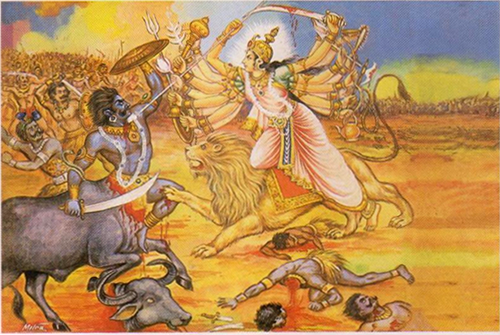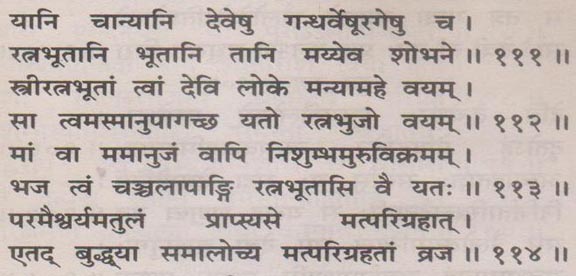Apr 19, 2024
Apr 19, 2024
Many philosophers, sages, psychologists and writers have reiterated the fact that the original power in this world springs from the female. Jung, the famous psychologist, George Bernard Shaw, the famous playwright, Mahatma Gandhi and several other highly cultivated souls have realized that the prime mover in the play of existence is the female. She is the motivator; she is the cause. The male part is there to accomplish the physical side of the task. Together these two forces become what the Chinese call the Yin and the Yang. Indian sages realized this fact quite early.
The original source of power has always been described in the feminine gender − Adishakti, Prakriti, Urja etc. are all female names. The raw force which guides action is feminine. If we go by the original scheme of things, our world-view is bound to be woman-centric. Without trivializing the masculine force, we may say that any just, justified or justifiable world-view is bound to be woman-centric. What do we mean by the woman-centric world view?
A world which realizes the importance, role and power of the woman is woman-centric. It is a kind of thinking that does not talk about adjusting the needs of women or compromising with women or understanding their poor condition etc. It is a world-view which knows that the woman is powerful; that there can be no world without women and finally it is dangerous and suicidal to hurt or destroy the sensibilities or self-dignity of women. Women are at the very heart, the center of this kind of vision.

Shri Durga Saptshati is a unique text. It is soaked in the female power. The names of the chapters give us an idea of the kind of text it is. The first chapter is named as ‘The Killing of Madhu and Kaitabh’; the second chapter is named as ‘The Killing of the Army of Mahishasur’; the third chapter is ‘The Killing of Mahishasur’; the fourth chapter is named as ‘Worshipping of Shakradi Devi’; the sixth chapter is named as ‘The Killing of Dhoomra Lochan’; the seventh chapter is named as ‘The Killing of Chand and Mund’; the eighth chapter is named as ‘The Killing of Raktbeej’; the ninth chapter is named as ‘The Killing of Shumbh’; the next chapter is named as ‘The Worshipping of the Devi’; and the next two chapters are again in the worshipping of the Devi.
Now, here is a model where, the goddess is on a killing spree. It is time for all the devils of the world to die at the hands of the goddess. The multi armed, lion riding, blood drinking, sword wavering goddess is the idol here. We are asked to meditate upon this form of the goddess.
What are the psychological implications of reading, re-reading, listening and public recital of such a text? The answer is that Shri Durga Saptshati takes women out from the realm of pity and puts them in the realm of power. The woman is the controller of events. The female spirit is conceived as the original power in this game of existence:

(The goddess has the power even to disturb the calm of the seers.
She and she alone creates this movable-immovable world.)
The text is overflowing with the description of the bravery of the goddess. Her valor is unparalleled. She is the epitome of all that is good beautiful, desirable and bright.

(All light came into the form of a woman and enlightened the three worlds).
What is noteworthy is that the goddess does not only embody light, beauty and desirability. She also embodies wrath, ugliness and cruelty par excellence. This is a text soaked in valor. There’s no forgiving, or ‘live-let-live’ theory here. It’s all tit for tat. The goddess showers her blessing on those who ask for it. At one point she goes on to say that if it does not rain even for hundred years, She world become moisture and world nurture human race. She promises to protect everyone who comes under her protection. But She has no sympathy whatsoever for demons. In fact, the whole text suggests that if women are not respected, there would be complete ruin and devastation. In my limited grasp, I felt that the text reinforces the adulation of the female power. It inculcates a kind of fear that if sensibilities of a woman are hurt, nothing will remain safe or intact.
It is a masterly narration where Shumbh dares to propose to the goddess. The goddess is virtue itself. Shumbh is a demon and yet he sends his emissary to propose to her.

(Shumbha’s message: We have all the jewels in the world except you.
Among women, we know that you are the jewel.
Come to us because we are meant to enjoy all the good things in life.
O beautiful breasted, come to serve either me or my brother Nishumbh.
We’ll stuff you with all wealth and luxury.
Use your brain and become our wife.)
There is no higher insult to a woman than trying to touch her dignity. This is verbal violence on part of Shumbh, indicative of his dirty mind-set and evil designs. But the best part is yet to come. The goddess smiles within herself, apparently agrees that Shumbh and Nishumbh are very powerful indeed and then gives her verdict:

(The one, who will defeat me in a war, will be my master.
Let Shumbh and Nishumbh come and defeat me and marry me without any delay)
The words of the goddess are so very effective. She gives a counter proposal. She invites them to a battle. I read a challenge to patriarchy in these lines. The one, who would defeat her, would be her master. No one would defeat her and therefore no one would be her master. She has defied masterhood of a man. At one point, she even asks Shiva himself to be her emissary and Shiva willingly does the job for her. This brutal, primal force of the woman is without a master. She is free. She is worship-worthy.
These are highly symbolical, highly allegorical words. The female force is not to be challenged. The female force is not to be insulted. Let women be happy and free. A free and happy woman is a boon. An exploited, insulted woman is a curse. The curse is potent enough to finish the likes of Mahishasur, Chanda Munda, Shumbha, Nishumbha, Dhromralochan etc. There’s no future for someone who has insulted a woman.
When such a text is read, re-read, recited, listened and understood, what would be its implications? Do we not need this is today’s India, in today’s world? We willfully borrow ideas of catharsis and purgation and believe that we have found the key to our sick mind-set. But such a powerful text as this not only purges the mind; it even creates and develops a new mind-set. Whenever we read Shri Durga Saptashati, we should also read and recite its translation so that the message goes deep and far.
The goddess is not just an idol of clay, metal or stone. She is a force. She is the original force. She is the breath that permeates existence. She is the consciousness that runs through existence. We should realize this. We are so deep drenched in Western classifications that we forget that we have a much more potent model of womanhood than the West. The concept of gender equality is dwarfish here; it is limited and insufficient. We are asking for a room when the whole house is ours. That’s why I said in the beginning that it is a world view that does not accommodate women or compromise with their view or pity them. It is a world view that sees existence, its cause, nurturing and destruction in a woman. The female force permeates the world view. Long and complete chapters are written in the “Stuti” (adoration, worshiping) of the goddess. All the forces of Nature pray for the love and mercy of the female power. That's Shri Durga Saptashati for us. Some may say that it is a very tribal text, a very primitive approach. It reinforces the need of inculcating fear. But even in today’s world, no one can deny the role of fear in managing society.
Fear, weakness, doubt or any negative emotion does not come even anywhere near the goddess. She kills all the demons (symbolic as well as real ones) in a second.

(The goddess kills the army of demons
just as fire finishes the bulk of dry grass in a minute.)
The woman does not ask for compassion. Everyone else must ask her for her compassion. The text completely reverses the master-slave, ruler-ruled dynamics. There no doubt here that the goddess is supreme.
Written in beautiful, poetic, emotional and powerful language, the text provides so many meaningful names for the goddess − the lotus-eyed, the moon-faced, the joy giver, the slender waist etc. When she becomes angry, she gets black – Kalika. When she kills Chanda-Munda, she becomes Chamunda. When she finishes Mahishasur, she is called Mahishasurmardini. The text does not shy away from the ‘raudra’ (gory) form of the goddess.
At one point, she faces the difficulty of finishing the demon called Raktabeej. Today, children are thrilled watching Hollywood movies of vampires or Dracula. But centuries before Christ, our sages had conceived the original vampire, the original Drakula – Raktabeej. His blood was his seed. As the goddess beheads him, his blood falls on ground and each drop creates a new, more powerful Raktabeej. Finally, the solution comes simple to the goddess.

(The goddess drank the blood of Raktabeej
and chewed the demons that sprang from his blood in her mouth.)
This is the kind of limit attributed to the female force.
I used the words ‘woman-centric world-view’ because better words did not come to me. But if I step a little further, I can say that the woman is the world. The woman is the other name of what we call the world. This is a very powerful text. It takes our imagination to points where it has not gone earlier. It is a very revolutionary text. Its spirit is worth emulating.
(All quotations have been taken from the original ‘Shri Durga Saptshati’ )
This lecture was delivered on 13, july, 2013 by the author at a refresher course for Asst. Professors at Pandit Ravi Shankar Shukla University, Raipur, Chhatisgarh, India.
24-Jul-2013
More by : Prof. Shubha Tiwari

|
Breathtaking, M'am! So powerful. Awesome, M'am, Awesome! |

|
Wonderful and impressive. If Prakruti or Devi is all forces in the world ( or the world itself ) philosophically, what is Purush? Yogis say He is merely Observer as against in the article Purush does just the physical act. |

|
What an impressive write-up. O my God! So powerful! |

|
The scriptural text does bring out the power and the glory of Ma Durga with extraordinary power. Shubha Tiwari is one of the millions of devout worshipers of the supreme mother deity. Only 'spree' is not a very nice term our professor used - in a lecture. Spree is explained as a 'lovely frolic' - a lively, merry time -in the lexicon. The Mother's act was far from that and we all know that. aarya vyavaharrmbula dushtambu graahyambu - (my Sanskrit may be faulty!) goes the grammarian's principle. (In the expressions of the learned the faults are to understood as acceptable). Thanks for the essay, erudite Shubha Tiwariji! All the best Rama Rao |